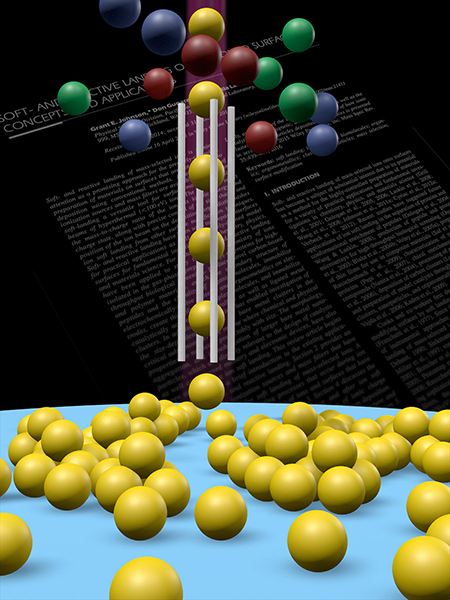The Hard Facts about Soft Landing Ions
Scientists review cutting-edge techniques that offer insights into processes of interest for energy production, storage, and catalysis
(April 2016)

Scientists at Pacific Northwest National Laboratory wrote an invited review on soft- and reactive-landing techniques, where a focused beam of selected ions are deposited onto a chosen surface. The review article provides a comprehensive look at ion landing instruments and research. Artwork by Nathan Johnson, PNNL
When determining how complex molecules drive, hinder, or halt reactions relevant to fuel production, pollution abatement, and energy storage, scientists often contend with other unrelated molecules that obscure their studies. Some researchers avoid these troublemakers by using ion soft- and reactive-landing techniques. With these methods, molecules are precisely sorted by their mass-to-charge ratio, kinetic energy, and ionic charge state. The scientists can concentrate the purified molecules into a beam and control its size, shape, and position to prepare highly tailored films and structures.
At Pacific Northwest National Laboratory, Dr. Julia Laskin, Dr. Grant Johnson, and Dr. Don Gunaratne took on the challenge of reviewing these techniques. They wrote a 40-plus page article in Mass Spectrometry Reviews that covers hundreds of studies. The authors were invited to write the review because of their expertise in developing ion soft-landing instruments and applying the instruments to fundamental studies in catalysis, materials synthesis, and energy storage.
Why It Matters: Soft and reactive landing of ions create high-value materials, from novel films for catalysis and batteries to protein arrays for high-throughput biological screening. The team's article reviews decades of research, pulling out key examples and explanations. The article is of interest to those studying the properties of individual molecules and their mesoscale assemblies on surfaces.
Methods: To determine the scope of the article, the team reviewed hundreds of studies from universities, national laboratories, and other institutions around the world. The article covers the instruments and their applications along with the structure and behavior of the materials produced. Special attention is devoted to small clusters, nanoparticles, and proteins. "Ion soft landing is a powerful tool for looking at the collective behavior of assemblies of molecules and clusters as part of DOE's new thrust in mesoscale research," said Johnson.
What's Next? "The next stage for soft landing research is developing it to do 3D printing at the molecular scale," said Laskin. "We aren't there yet, but that's the research direction that will yield the largest payoff in terms of materials synthesis and other applications of interest to DOE."
Acknowledgments
Sponsors: U.S. Department of Energy, Office of Science, Office of Basic Energy Sciences, Chemical Sciences, Geosciences, and Biosciences Division and Pacific Northwest National Laboratory's Laboratory Directed Research and Development fund
Research Area: Chemical Sciences
Research Team: Grant Johnson, Don Gunaratne (now with Intel Corporation), and Julia Laskin, Pacific Northwest National Laboratory
Reference: Johnson GE, D Gunarantne, and J Laskin. 2016. "Soft- and Reactive Landing of Ions onto Surfaces: Concepts and Applications." Mass Spectrometry Reviews 35(3):439-479. DOI: 10.1002/mas.21451
Related Highlights
The Softer Side of Control without Clumping or Capping
Electron-Rich Ions Retain Charge When Softly Landed
Soft Landing and Particle Coverage Key to Keeping or Losing Charge on Surfaces
Employing Ions Allows Scientists to Precisely Design Innovative Materials
